

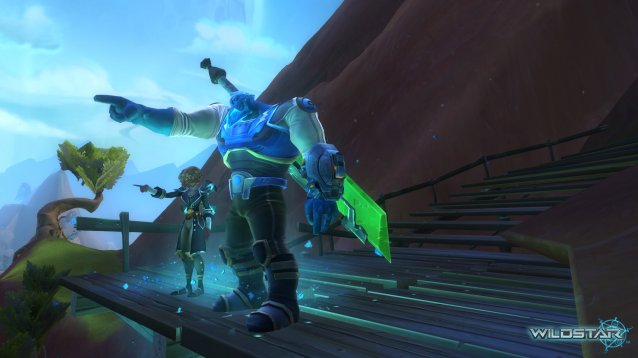
WildStar, Carbine Studios up-and-coming MMORPG was at E3 this year, and it brought with it all of its mirthful and often hilarious personality. At the expo, we were lucky enough to get some hands-on time with the game and chat with Tiffany Chu, social systems director and tutorial creator from Carbine Studios.
In WildStar you play a part in the world of Nexus, the mysterious world of a lost civilization known as the Eldan. As with any newly discovered and treasure-ridden planet, everyone who is anyone, even anyone who is no one, wants to be there.
Unfortunately this kind of planetary popularity also leads to conflict. In the game this conflict is established in a war between the Dominion, who claim ownership of the new world, and the exiles, who call Nexus home. As their war wages, however, each faction discovers that they are not alone on the planet. This somewhat open storyline opens countless opportunities for WildStar, including the capacity for well-established lore, faction based PvP, and strong end-game content.
Tiffany Chu is in charge of working the backbone of what makes the overall MMO experience—the social systems. She is also currently working on game play tutorials. "Our game has a lot of unique systems," said Chu, "so I want to make sure that players learn about them at a good pace. I don't want to frontload you with all of the information—you don't need to know everything right away. That can discourage you or overwhelm you."
In the demo, the unique style of this game is immediately evident and memorable. Choosing from one of the six races and four classes, I entered the world as a human spell-slinger. The game hilariously mocked my decision with the message, "It seems you were painfully birthed a human, the most common race in the entire galaxy. Seriously, these guys are over the place..." It's obvious that part of the fun in WildStar lies in its artistic design and witty humor, which is encountered from the very start of your character's creation.
When asking Chu about the roles of each character class, she mentioned that they were going to be relatively flexible. If I were to pick a Stalker—a rogue-like DPS class—I could perform traditional dps. However, if I decided I wanted to tank in dungeons, I could also get abilities that would allow my character to evade and dodge tank. This is an aspect that can provide the player with a completely different experience than the time-honored warrior tank and spank.
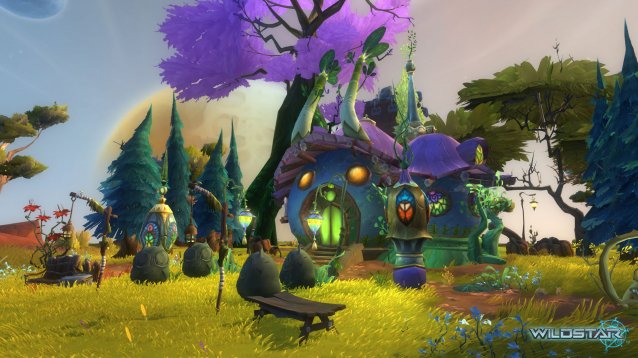
Paths are also a distinctive addition to character creation in WildStar. As of now, there are four paths offered in the game: explorer, solider, settler, and scientist. Each path helps to tailor to the player's style of game play and will eventually offer unique individual abilities.
"Paths are another layer of an attribute you pick for your character. You pick your race, your gender, your class, and then after that you pick your path," said Chu. "You're saying, 'I enjoy this type of content and I am this type of player and I would like to have content in the game that encourages me and rewards me for doing these things.'"
"So if your an explorer," she continued, "the game adapts to your style and encourages you to discover different parts of the land. If you're a soldier, you get more fighting missions and experimental weapons. You know... here is a rocket launcher, see what happens with it!"
Each path is designed to adhere to specific play styles. The scientist, for example, is what Chu called the "lore-hound." They have a customizable scan bot that can search the environment for background information. The settler, who Chu rightfully dubbed the “care bear,” can build and repair different items and create useful stat boosters such as buff stations that can be used by other players
This time around, I chose the path of soldier, as my style of play is heavily combat driven. Upon entering the world, I was accosted by a plethora of battle quests. Once I adjusted to the straight-forward controls, I began to search the small town for skulls that would later help me summon and defeat a spirit. For those who are directionally-impaired like me, there is a nifty compass that can guide you to your next goal, making it easy to explore even the most foreign of territories.
In regard to the game's style, Chu explained, "We know that when you go realistic, it's very easy to look out-dated rather quickly; we want to go long-term. It also allows us to play up some of the humor. We don't really take ourselves that seriously. We are going for a certain vibe." And WildStar does give off a unique vibe. The art-style for the game is beautiful and vibrant, somewhat reminiscent of games like World of Warcraft. The starting area is coated with an intense autumn hue that stretches far into the background. Lively and vibrant colors cover the surrounding buildings, giving way to a playful environment that encompasses a mixture of fantasy and sci-fi, featuring Satyr-like creatures and ancient ritual altars alongside spaceships and laser guns.
After the unfortunate sacrifices of some War Pigs (which may serve as potential mounts later on) and some run-ins with adorable critters, I finally got to experience WildStar's combat system, and I was thoroughly impressed by it. The overall controls of the game are organic, and the addition of the sprint and double jump combo—though simplistic—are some of the best additions to an MMORPG that I have seen. While the double jump is amusing to use when exploring the world, it truly excels in combat.
During the mini-boss fight with the spirit, I was forced to plan attacks around potent AOE spells, which appeared in a glowing red color on the ground. At my level, this type of AOE attack had the potential to one-shot me. However, with use of a well-timed double jump, I was able to clear the AOE, rush behind the boss, and land some critical hits. The double jump feature keeps fighting fresh and adds a level of strategy rarely felt in the MMO genre—I can't wait to experience it in PvP and end-game content.
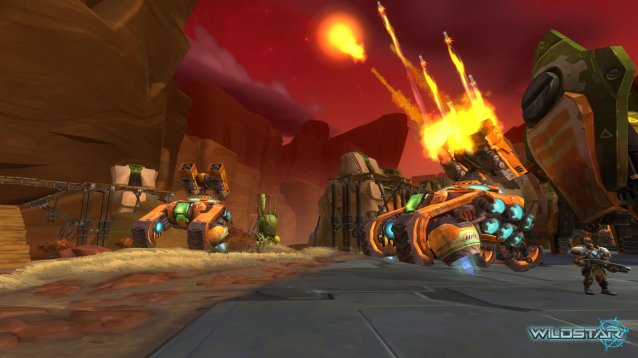
Speaking of end-game, WildStar will have a lot. And it will cater towards the needs of both hardcore and casual players.
"We have a little bit for everyone. But when we say something is for hardcore players, it's for hardcore players. When we say it’s for casual players, it is. And it will be fun and enjoyable," said Chu, "For raiding, we have hard core [40 man raids], but we also have 20 man raiding for more casual players." Chu also explained that in much of the hardcore content items can also be permanently lost.
You heard correctly, WildStar is bringing back the 40 man raid, something not seen since the days of Vanilla WoW. If that weren't enough to get old-school raiders excited, there has already been a "Leroy Jenkins" moment during beta testing, which promises that raids will be the reactive and strategic group dungeons we have grown to know and love in games like WoW.
"You need to time you interrupts specifically and have your order of rotation down. It takes you back to Molton Core days. We aren't messing around with the raids. We aren't afraid to make them difficult and we aren't afraid of pulling punches—we’re going to make it work." said Chu.
Another unique aspect of WildStar is the housing. In the game, each character can create and personalize a plot of land. Houses are instanced per player, but you can still invite friends over to show off your personal pad whenever you please.
While we didn't get to see any examples of housing in the demo, Chu was kind enough to share some information on it. She explained that despite being instanced, the housing is still tied into multiple aspects of the game. "Housing is tied into a lot of other systems. It is tied into groups, so you get a different currency in which you can buy various items of decor, it is tied into trade skills, so crafting and harvesting. While you can mine out in the world, it is possible to mine in your own home if you happen to have a query, and you don't need to share."
In terms of personalization, Chu mentioned that it is possible to decorate both the interior and exterior of your house with things like windows, potted plants, or even cannons. Yes, cannons.
Another thing you can customize your house with are micro functions—like a gladiator rings—in which you can perform fighting challenges. I don't know about you guys, but I have always wanted a gladiator ring in my house. And a cannon, for that matter.
So why have a cannon in your house if it will never be used? Decoration, duh. But that is beside the point in WildStar. In the game's context, the cannons are used for defense. Chu pointed out to us that housing is also a part of hardcore PvPing using what is called a war plot. "We have war plots, another feature that we just started to talk about. You and a party of your friends can form a party called a war party, similar to a guild but more PvP oriented. You go out and collect resources for you party—maybe an ion cannon, laser shields, whatever you want to put on your shared property. Then you go in and fight with another party." War Parties are a separate feature from guilds, so it is possible to have both a guild and war party.
"This is for hardcore PvPers," Chu said. "Those things [gathered for the war plot] can get destroyed in the battle."
Between 40 man raids, housing, paths, a unique art-style, and content for players of all types, WildStar promises to fuse some of the best attributes in the MMORPG genre with a candor and quality all its own.
WildStar is currently in closed-beta, and will be released sometime in 2013. Want more information on Nexus to hold you over in the mean time? Check out wildstar-online.com.

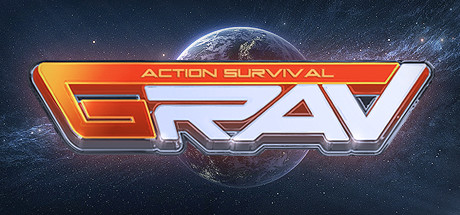


 Watch Dogs Guide to Fix Mouse Acceleration for Windows 7 and Windows 8
Watch Dogs Guide to Fix Mouse Acceleration for Windows 7 and Windows 8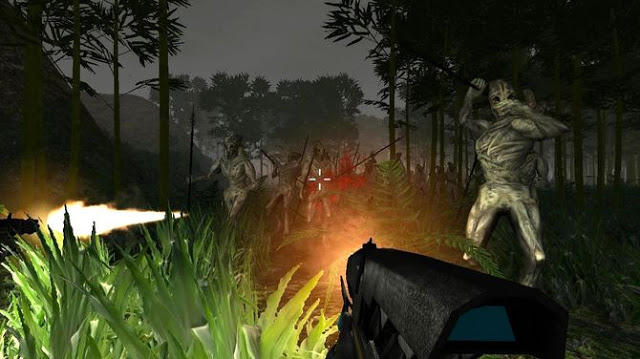 Empyrion Galactic Survival (PC) tips
Empyrion Galactic Survival (PC) tips Citizens of Earth Wiki – Everything you need to know about the game .
Citizens of Earth Wiki – Everything you need to know about the game .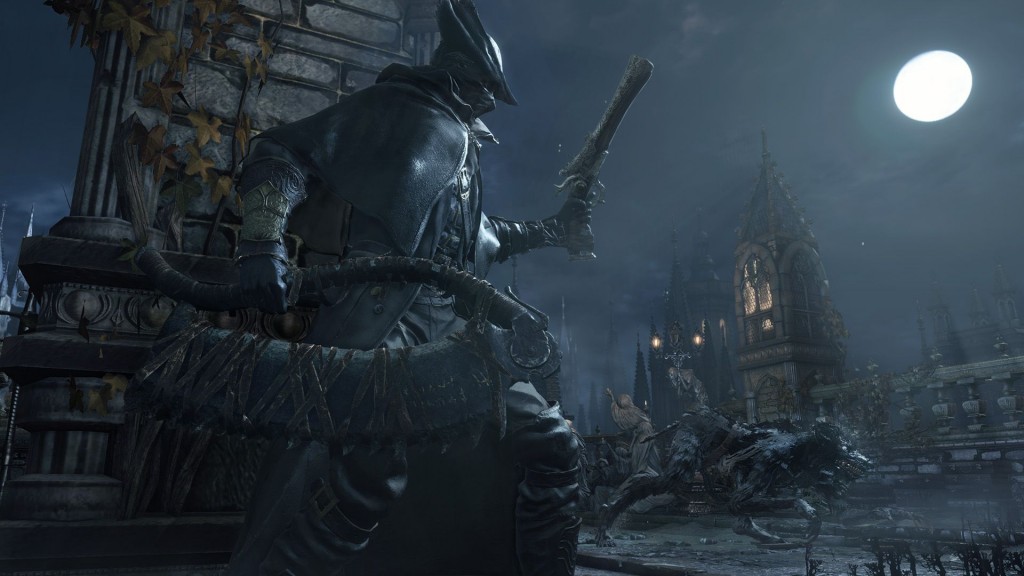 Bloodborne Boss Guide: Best Way to Fight and Beat Father Gascoigne
Bloodborne Boss Guide: Best Way to Fight and Beat Father Gascoigne AC Syndicate: How to Get All Weapons (Kukris, Cane-Swords, Knuckles, Gauntlets, Firearms)
AC Syndicate: How to Get All Weapons (Kukris, Cane-Swords, Knuckles, Gauntlets, Firearms)